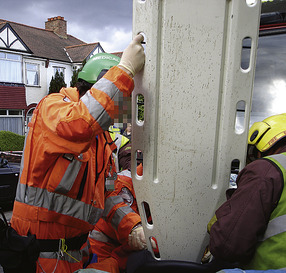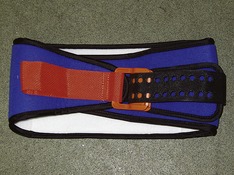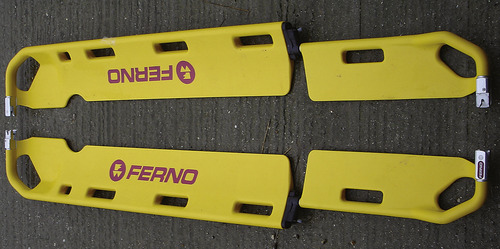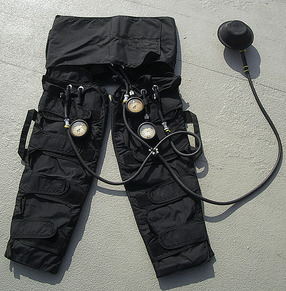Case 7
Incident
• Alert with a clear airway but laboured breathing.
• Weak radial pulse (58 beats per minute).
• Crush injury to pelvis and bilateral open femoral fractures.
• Partial amputation just below right knee.
• Not physically trapped but in severe pain.
He has had two unsuccessful attempts at gaining intravenous access.
In addition to your standard pre-hospital equipment, the following items are available to you:
Questions
7.1 For each of the devices illustrated, outline briefly how they are used.
7.2 What are the benefits and limitations of each device in the management of pre-hospital trauma?
7.3 How will you utilise this equipment in the management of this case? You may select all, none or some of the equipment available. Are any pieces of equipment contraindicated?
Discussion
7.1. Extrication board
Used for removing patients from confined or difficult access areas. Frequently used for facilitating extrication from a motor vehicle (rear, vertical or seated rotation and side door egress) by sliding the patient onto the device. This piece of equipment is also useful, with the patient supine upon it, in extrication over uneven or rough terrain such as through tunnels or collapsed structures where lighter devices (i.e. Sked or Chrysalis rescue stretchers) are not available.
Pelvic splint
Applied when there is a confirmed or suspected pelvic fracture. Requires planning for application (i.e. at the time of patient packaging) and must be placed in alignment with the greater trochanter on each side. Many pelvic splints are single use and have a force/tension measurement capacity.
Scoop stretcher
Drawn out to length and divided into left and right sections by lock release at head and foot ends. Placed one side at a time under the patient with gentle (20 degrees) log roll following exposure and clothes removal. The head and foot end are then locked and secured.
Intraosseous access device
Used to assist the placement of an intraosseous (IO) cannula by providing battery- powered high-speed drilling of bevelled, hollow drill-tipped needles. Provides secure, controlled vascular access via the IO route to patients of all ages in emergency situations when vascular access is challenging or impossible. The intraosseous space allows drugs and fluids to reach the central circulation as IO vascular flow continues even in shocked states.
Femoral traction splint
Used in the stabilisation and reduction of femoral shaft fractures. This device has an ischial bar placed against the perineum on the side of the injury avoiding direct genital pressure. Ankle harnesses and straps attached to the distal traction component allow for measurable dynamic traction to both femurs as required. Large elastic leg cravats are then applied in order to minimise mid and lower limb movement.
< div class='tao-gold-member'>
Only gold members can continue reading. Log In or Register to continue
Stay updated, free articles. Join our Telegram channel

Full access? Get Clinical Tree














